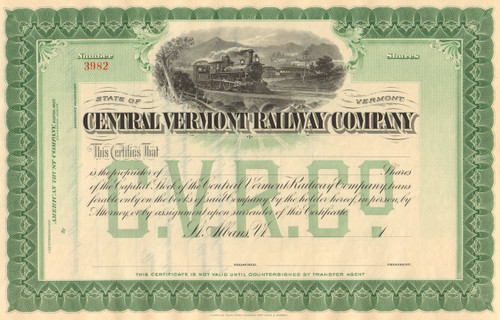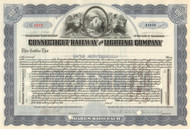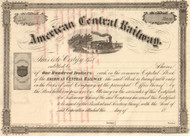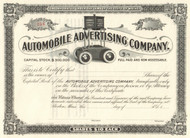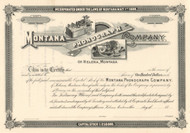Categories
Categories
- Home
- Railroad
- 1800's Railroads
- Central Vermont Railway Company circa 1899
Central Vermont Railway Company circa 1899
Product Description
Central Vermont Railway Company stock certificate circa 1899
Uncommon railroad collectible. Great vignette of a steam train rounding a curve pulling passenger cars. Unissued and not cancelled. Dated 1___. Circa 1899 from company records.
The Vermont Central Railroad was chartered October 31, 1843 to build a line across the center of Vermont, running from Burlington on Lake Champlain east to Montpelier, and then southeast and south to Windsor on the Connecticut River. Initial plans had the main line running through Montpelier. However, due to the difficulty of building through the Williamstown Gulf, a narrow valley south of Barre, Vermont, and to land interests of Charles Paine in Northfield, Vermont, a course to the west was selected, leaving the state capital to be serviced by a short branch line.
The Vermont and Canada Railroad was chartered October 31, 1845. On August 24, 1849, the Vermont Central leased the Vermont and Canada, and it was completed in 1851. However, the Vermont Central defaulted on rental payments, and the Vermont and Canada returned to its original owners on June 28, 1852. The Montreal and Vermont Junction Railway was chartered in 1860 and opened in the 1860s, extending the Vermont and Canada's branch from the international border north to St. Johns, Quebec on the Grand Trunk Railway's Montreal and Champlain Railroad. From opening it was operated as an extension of the Vermont and Canada.
The Sullivan County Railroad continued south from Windsor to Bellows Falls, where it met the Cheshire Railroad towards Boston. At first it was operated by the Central Vermont, but later the Boston and Maine Railroad gained control of it, giving track rights to the Central Vermont. Similarly, the Vermont Valley Railroad, running south from Bellows Falls to the New London Northern Railroad in Brattleboro, was originally owned by the Rutland Railroad and later by the B&M. In 1867 the Vermont Central leased the Stanstead, Shefford and Chambly Railroad, running east from St. Johns to Waterloo. The Waterloo and Magog Railway was later built as an extension from Waterloo south to Magog.
The Vermont Central leased the Ogdensburg and Lake Champlain Railroad on March 1, 1870, extending its line from Rouses Point west to Ogdensburg. On January 1, 1871, the Vermont Central leased the Rutland Railroad system, giving it routes from Burlington to Bellows Falls and Chatham, New York. The New London Northern Railroad was leased on December 1, 1871. On November 2, 1872 the name was changed to the Central Vermont Railroad. Though chartered as an independent entity in 1867, control of Missisquoi Railroad was gained shortly thereafter, and it was formally leased in July 1873, providing a branch from St. Albans northeast to Richford. It was operated until November 15, 1877, when the Connecticut and Passumpsic Rivers Railroad took it over. The company was reorganized in December 1886 as the Missisquoi Valley Railway, and was once again leased to the Central Vermont.
The Montpelier and White River Railroad opened in 1876 and was leased to the Central Vermont, running from the end of the Montpelier Branch south to and beyond Barre. The Consolidated Railway was formed on June 30, 1884, to consolidate the Central Vermont and Vermont and Canada and to settle litigation between the two companies. A new Central Vermont Railroad was formed on July 1, 1884 to take over from the Consolidated Railway.
In 1889 the Burlington and Lamoille Railroad was reorganized as the Burlington and Lamoille Valley Railroad and leased by the Central Vermont. This provided a branch from Essex Junction to the Lamoille Valley Railroad at Cambridge Junction in Cambridge, Vermont, and a quickly-abandoned redundant line from Essex Junction west to Burlington. This second connection crossed the Winooski River near Essex Junction and connected to the Rutland Railroad at the south end of Burlington.
The Montreal and Province Line Railway was formed in 1896 as a reorganization of the Montreal, Portland and Boston Railroad. Originally planned as a branch of the Portland and Ogdensburg Railroad to Montreal, and operated by the Connecticut and Passumpsic Rivers Railroad, it was taken over by the Central Vermont upon reorganization. The main line ran from the Grand Trunk Railway's Montreal and Champlain Railroad at Saint-Lambert, across the St. Lawrence River from Montreal, southeast to Farnham on the Stanstead, Shefford and Chambly Railroad, with an extension continuing southeast to Frelighsburg. A branch went east from Mariesville to St. Cesarie.
On July 12, 1920, the entire Grand Trunk system was placed under the control of a "Board of Management" by the federal Department of Railways and Canals in Canada after several years of financial difficulties. After several years of legal battles by Grand Trunk shareholders, intent on preventing the federal government from nationalizing the company, the company was nationalized on January 20, 1923, and fully merged into the Crown corporation Canadian National Railway.Under the Grand Trunk and later the Canadian National, the Central Vermont system saw many of its unprofitable branch lines abandoned. The CN continued to operate the CV as a modestly successful system, however in the process leading up to the privatization of the CN, which took place on November 28, 1995, several non-core routes were identified for sale - one of these being the CV.
On February 3, 1995, the CN sold the CV mainline from New London, Connecticut, to East Alburg, Vermont, to short line operating company RailTex, which renamed the property New England Central Railroad. RailTex was merged into RailAmerica in 2000. Genesee & Wyoming acquired RailAmerica at the end of 2012. Operations have continued to present as before.
 Loading... Please wait...
Loading... Please wait... 
